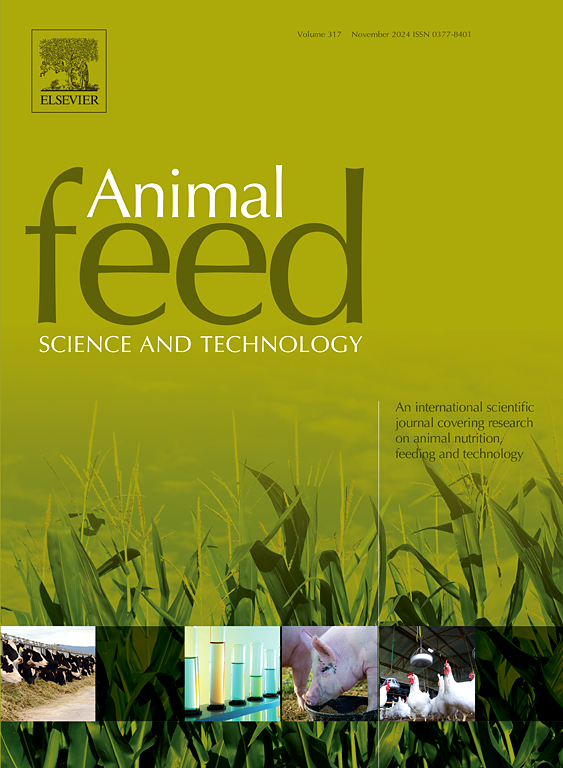Effect of feeding two types of concentrates in morning and evening meals and two types of fat supplement on diurnal patterns of plasma parameters in lactation dairy cows
IF 2.5
2区 农林科学
Q1 AGRICULTURE, DAIRY & ANIMAL SCIENCE
引用次数: 0
Abstract
The diurnal patterns of feed intake and TMR composition influence blood parameters in dairy cows; however, the effect of feeding TMR with different compositions in the morning and evening meals is not well characterized. In a completely random design, forty Holstein cows (110 ± 30 days postpartum) were randomly assigned to four treatment groups, with 10 cows per treatment. The treatments were as follows: a base diet containing 50 % cereal starch from barley grain and 50 % cereal starch from corn grain in the morning and evening meal + either prilled fatty acids supplement (EqP) or calcium salts of fatty acids supplement (EqCS); a base diet containing 25 % cereal starch from barley grain, 75 % cereal starch from corn grain in the morning meal, and 75 % cereal starch from barley grain and 25 % cereal starch from corn grain in the evening meal + either prilled fatty acids supplement (DiP) or calcium salts of fatty acids supplement (DiCS). Dry matter intake was affected by treatments (P ˂ 0.01). The highest intake was observed for EqP, EqCS, DiP,and DiCS. 3.5 % fat-corrected milk and milk fat percentage was significantly higher for EqP than other treatments (P ˂ 0.01), but other milk components were not significantly different among treatments (P ˃ 0.05). A significant difference was observed for glucose, cholesterol, TG, AST, and insulin concentration among treatments (P ˂ 0.01). The concentrations of all plasma parameters (glucose, cholesterol, TG, BUN, AST, insulin, and NEFA) significantly changed over 24-h period (P ˂ 0.01). Plasma concentrations of glucose, cholesterol, TG, BUN, AST, insulin, and NEFA displayed a treatment-by-time interaction (P ˂ 0.01). In general, changes in the cereal starch ratio (corn and barley) in TMR in each meal during a day affect the 24-h concentration of plasma parameters, but there was no strong evidence of leverage for cows’ metabolism.
早晚饲喂两种精料和补充两种脂肪对泌乳奶牛血浆参数昼夜变化规律的影响
采食量和TMR成分的昼夜模式会影响奶牛的血液参数;然而,早晚饲喂不同成分的TMR所产生的影响还没有得到很好的描述。在完全随机设计中,40 头荷斯坦奶牛(产后 110 ± 30 天)被随机分配到四个处理组,每个处理组 10 头奶牛。处理方法如下基础日粮(早晚各一餐,其中大麦谷物淀粉和玉米谷物淀粉各占 50%)+脂肪酸颗粒补充剂 (EqP) 或脂肪酸钙盐补充剂 (EqCS);基础日粮:早餐含 25% 的大麦粒谷物淀粉、75% 的玉米粒谷物淀粉,晚餐含 75% 的大麦粒谷物淀粉和 25% 的玉米粒谷物淀粉 + 预混脂肪酸添加剂 (DiP) 或脂肪酸钙盐添加剂 (DiCS)。干物质摄入量受不同处理的影响(P ˂ 0.01)。EqP、EqCS、DiP 和 DiCS 的摄入量最高。EqP 的 3.5 % 脂肪校正乳和乳脂率显著高于其他处理(P ˂ 0.01),但其他乳成分在不同处理间无显著差异(P ˃ 0.05)。葡萄糖、胆固醇、总胆固醇、谷草转氨酶和胰岛素的浓度在不同处理间存在明显差异(P ˂ 0.01)。所有血浆参数(葡萄糖、胆固醇、总胆固醇、BUN、谷草转氨酶、胰岛素和 NEFA)的浓度在 24 小时内均有显著变化(P ˂ 0.01)。血浆中葡萄糖、胆固醇、总胆固醇、BUN、AST、胰岛素和 NEFA 的浓度显示出处理与时间的交互作用(P ˂ 0.01)。总的来说,一天中每餐 TMR 中谷物淀粉比例(玉米和大麦)的变化会影响血浆参数的 24 小时浓度,但没有强有力的证据表明这种变化会影响奶牛的新陈代谢。
本文章由计算机程序翻译,如有差异,请以英文原文为准。
求助全文
约1分钟内获得全文
求助全文
来源期刊

Animal Feed Science and Technology
农林科学-奶制品与动物科学
CiteScore
6.00
自引率
6.20%
发文量
266
审稿时长
3 months
期刊介绍:
Animal Feed Science and Technology is a unique journal publishing scientific papers of international interest focusing on animal feeds and their feeding.
Papers describing research on feed for ruminants and non-ruminants, including poultry, horses, companion animals and aquatic animals, are welcome.
The journal covers the following areas:
Nutritive value of feeds (e.g., assessment, improvement)
Methods of conserving and processing feeds that affect their nutritional value
Agronomic and climatic factors influencing the nutritive value of feeds
Utilization of feeds and the improvement of such
Metabolic, production, reproduction and health responses, as well as potential environmental impacts, of diet inputs and feed technologies (e.g., feeds, feed additives, feed components, mycotoxins)
Mathematical models relating directly to animal-feed interactions
Analytical and experimental methods for feed evaluation
Environmental impacts of feed technologies in animal production.
 求助内容:
求助内容: 应助结果提醒方式:
应助结果提醒方式:


